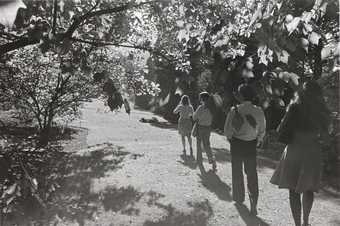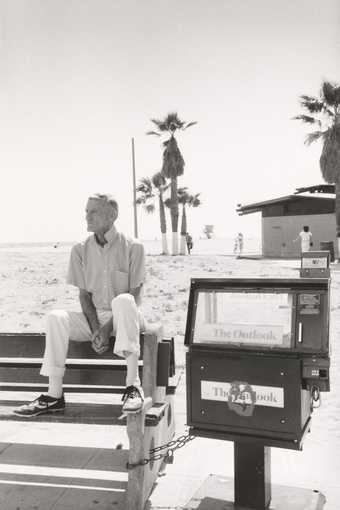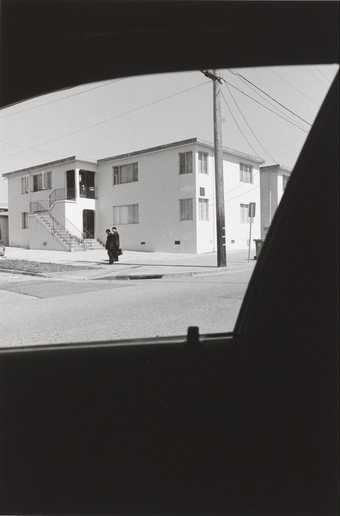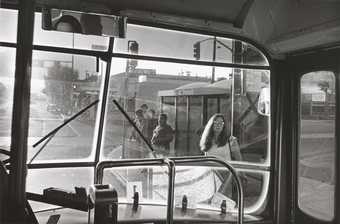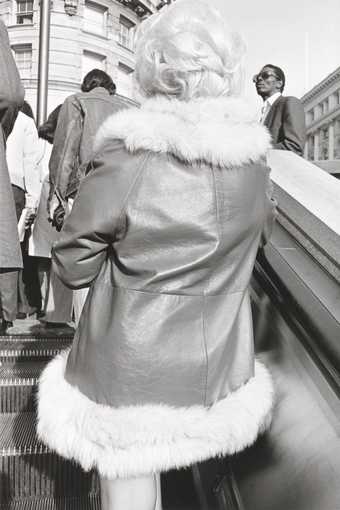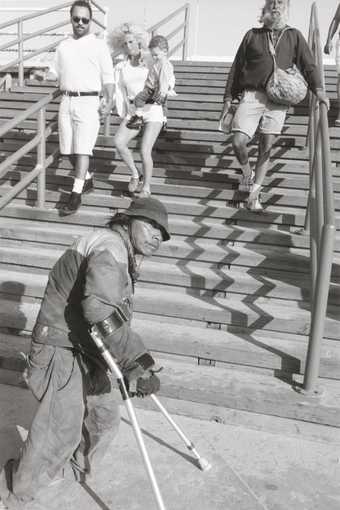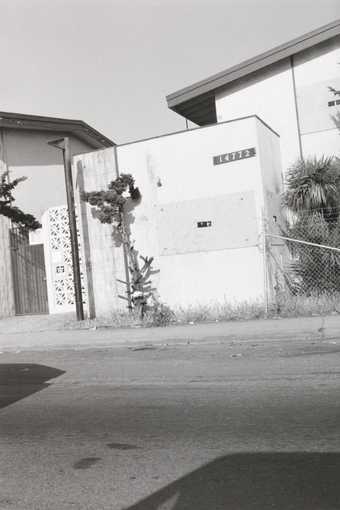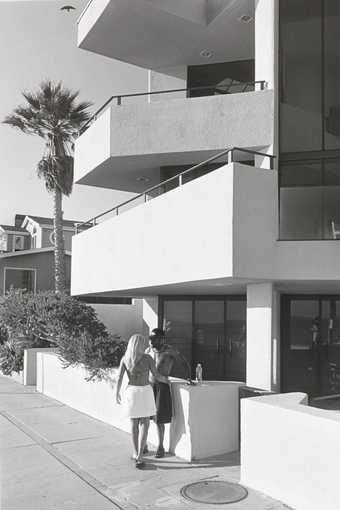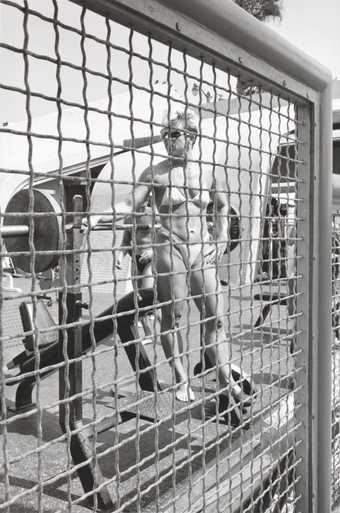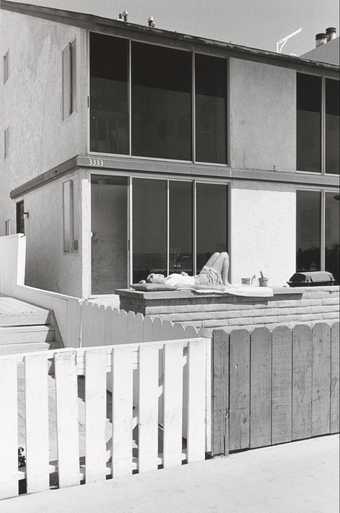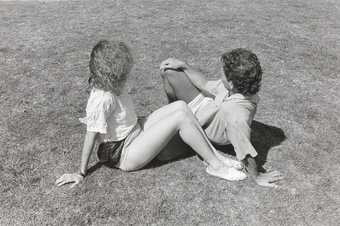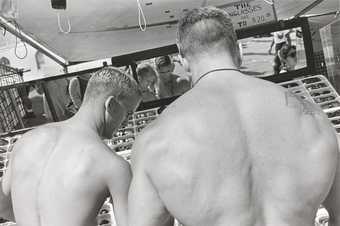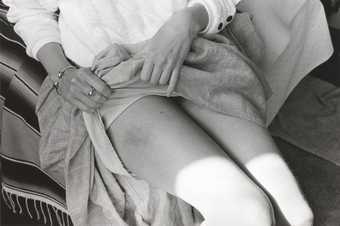
In Tate Britain
Prints and Drawings Room
View by appointment- Artist
- Henry Wessel 1942 – 2018
- Part of
- Incidents
- Medium
- Photograph, gelatin silver print on paper
- Dimensions
- Image: 278 × 417 mm
- Collection
- Tate
- Acquisition
- Purchased with assistance from Artworker's Retirement Society (Tate Americas Foundation) 2014
- Reference
- P80528
Summary
Henry Wessel’s Incidents 2012 is a portfolio of twenty-seven black and white photographs (Tate P80505–P80530); fourteen are landscape format and thirteen are portrait. The images make up a series, sequenced by the artist for a 2013 publication of the same name, which can be shown either in its entirety or in smaller selections. All but two of the photographs include figures. Some are seen engaging in specific activities – for instance, children playing (Tate P80509), a bodybuilder pausing mid-workout (Tate P80521) and a break in a tennis lesson (Tate P80517). However, most of the people pictured are either relaxing (such as the woman sunbathing in Tate P80522), or going about their daily business in the streets – catching buses (Tate P80511), shopping (Tate P80529) or simply walking around (Tate P80513). In Incidents Wessel mostly depicts moments in the everyday lives of strangers, captured in cars or public spaces, with varying degrees of supposed or projected narrative. Very few people in the photographs show any awareness of or interaction with the photographer. The feeling of immediacy to the ‘snapshots’, coupled with Wessel’s characteristic range of grey tones in representing the bright California sunshine, unites the portfolio. The photographs are each titled Incidents followed by the number that they appear in the sequence, and the portfolio was published in an edition of nine, of which this copy is number two.
Wessel took the photographs that make up Incidents over some forty years while working on other projects and only later collected and assembled them. In making the selection for the portfolio, he pasted 250 shots all over his studio and looked for connections between them (Andreasson 2014, accessed 28 August 2018). Some of these connections are conceptual, like the ideas of youth and ageing that are raised in the first three images (Tate P80504–P80506); while others are more formal, such as those that use the windows of vehicles as frames (Tate P80507–P80511). The process of assembling photographs made at different points during his career into new groups under a specific concept (in this case ‘incidents’) represents a key aspect of Wessel’s later practice.
Wessel has lived in the San Francisco Bay Area since visiting from New York in 1971, when he was struck by ‘the light, the variety of landscapes, and the urban centres’ (Wessel in Andreasson 2014, accessed 28 August 2018). The area and its distinctive sunshine have since been central to his practice. Rather than using telephoto lenses or hiding in wait for his subjects, Wessel’s photographs are taken from up close, with a wide-angle lens, and very much in the moment, when something strikes him. As the artist describes it: ‘I wander around until something catches my eye, trusting my instinct and taking a photograph when there are no words to describe an experience.’ (Wessel in Andreasson 2014, accessed 28 August 2018.) It is this practice that gives the images their immediacy, as though the photographer were on an assignment to watch or tail his subjects. Wessel’s interest in everyday incidents can be understood in relation to the tropes of detective fiction, and to the idea of assigning importance to mundane observations or significance to ordinary forms and appearances.
Wessel is known for his complex photographs which reach across genre boundaries, from landscape (during his association with the New Topographics group in the 1970s) to portrait, street and documentary photography. His style balances careful attention to formal compositions and the play of light and shadow with a sense of the drama and humour found in the everyday. Wessel is also known for his idiosyncratic photographic technique, by which he manipulates the black and white film both in the camera and in the darkroom to obtain a broad range of grey tones, avoiding the harsher contrasts of the ends of the black and white spectrum almost completely.
Further reading
Henry Wessel, Incidents, Göttingen 2013.
Karin Andreasson, ‘Interview: Henry Wessel’s Best Photograph: A Mystery in a California Garden’, Guardian, 6 August 2014, https://www.theguardian.com/artanddesign/2014/aug/06/henry-wessel-best-photograph-mystery-california-garden, accessed 28 August 2018.
Simon Baker
December 2012
Arthur Goodwin
October 2018
Does this text contain inaccurate information or language that you feel we should improve or change? We would like to hear from you.
Explore
- emotions, concepts and ideas(16,416)
-
- formal qualities(12,454)
-
- documentary(1,026)
- photographic(4,673)
- recreational activities(2,836)
-
- sunbathing(54)
- clothing and personal items(5,879)
-
- sandal(19)
- shorts(34)
- sunglasses(55)
- bench(233)
- actions: postures and motions(9,111)
-
- legs crossed(147)
- lying down(392)
- reclining(814)
- resting(40)
- woman(9,110)
- black(796)
- countries and continents(17,390)
-
- USA(622)
You might like
-
Henry Wessel Incidents 001
2012 -
Henry Wessel Incidents 003
2012 -
Henry Wessel Incidents 005
2012 -
Henry Wessel Incidents 007
2012 -
Henry Wessel Incidents 008
2012 -
Henry Wessel Incidents 009
2012 -
Henry Wessel Incidents 010
2012 -
Henry Wessel Incidents 012
2012 -
Henry Wessel Incidents 015
2012 -
Henry Wessel Incidents 018
2012 -
Henry Wessel Incidents 019
2012 -
Henry Wessel Incidents 023
2012 -
Henry Wessel Incidents 024
2012 -
Henry Wessel Incidents 026
2012 -
Henry Wessel Incidents 027
2012

